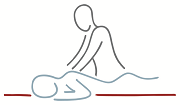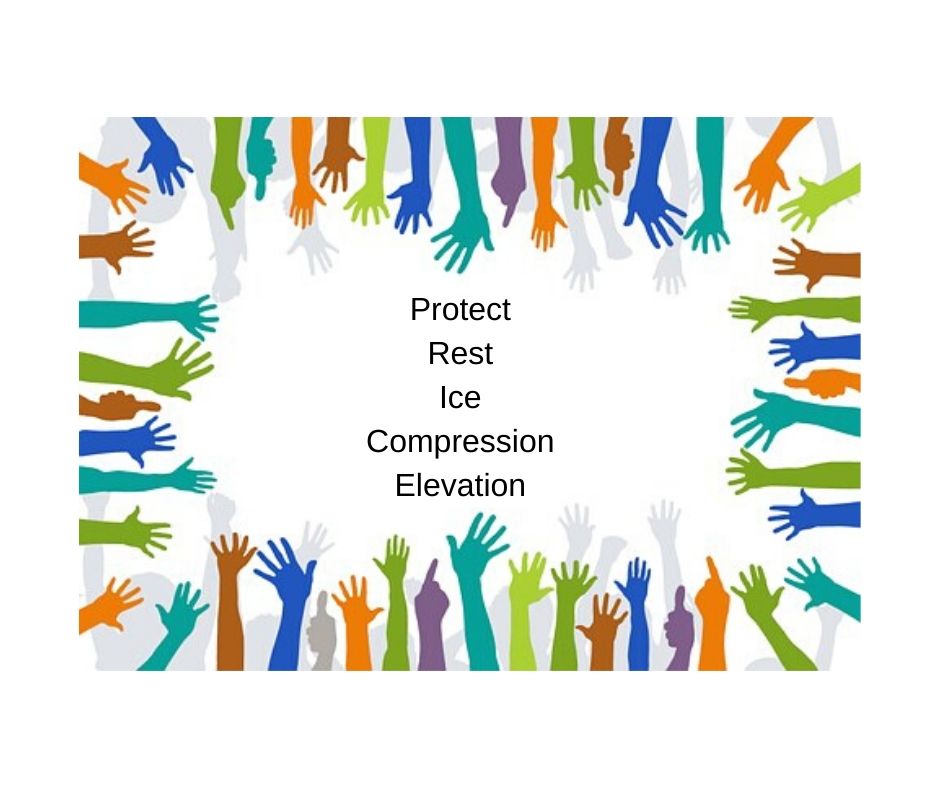During the acute inflammation stage of a soft tissue injury (24 to 48 hours), I would recommend the P.R.I.C.E. or P.OL.I.C.E. procedures:
After that, the injury can be managed with a combination of Gentle movement, Soft Tissue Therapy and Rehabilitation exercises. Please get in touch if you would like to discuss.
Protect –
The damaged area should be protected from further injury, bacteria and movement. This aims to prevent undue stress that may hinder the healing process or cause further damage. Immediately after injury, the protection may include bandaging/splints or simply removal from field of play and rest in a safe place. Tissue support can improve patient comfort and confidence, but complete immobilisation is not usually necessary or desirable. Any method of protection around the tissue should be able to accommodate any swelling that is to come.
Rest –
You should rest from any activity which may stress the injured area. This will prevent further damage and slow down the blood flow to the area. No real fitness will be lost in these first couple of days and the risk of further damage is therefore avoided. However, too much rest can be detrimental as it slows down recovery. Therefore, after resting for a minimum of 24 hours, gentle work of the injured tissues stimulates healing. Using the tissues in their normal way will encourage the new scar tissues to be laid down in the most effective manner. This process is called Optimal Loading. Loading usually involves progressive weight-bearing in conjunction with remedial exercises, stretching and light massage around, but not on, the injury site.
Ice –
Ice should be used as soon as possible to limit the body’s over reaction to the injury. The cold reduces superficial tissue temperature and induces pain relief to the area. It also helps to constrict the blood vessels, limits bleeding and reduces the accumulation of unnecessary tissue proteins that can cause adhesions between fibres and excess scar tissue. The ice should be applied wrapped in a damp cloth or plastic bag to protect the skin from “ice burns”. It should be applied for 20-30 minutes every 3-4 hours during the first 24-48 hours after injury. As well as pain relief, ice can also reduce swelling. Evidence as to how this happens is inconclusive but it is probably due to the blood flow reduction.
Compression –
Although some inflammation is necessary after injury, prolonged oedema is unwanted as it causes pain, leads to movement restriction in joints and muscle inhibition. Manual compression using off-the-shelf compression bandages or neoprene supports can limit an unnecessary accumulation of inflammatory fluid. These can be self applied. The area should be compressed above and below as well as over the injury site and any bandages or strapping should be applied by a trained practitioner so that they can accommodate any swelling and still maintain pressure as this swelling reduces. Compression should continue for the first 72 hours and pressure exerted should be reduced as time progresses as the aims of compression move from controlling blood flow to preventing excess oedema formation.
Elevation –
Elevation (and support) of the injured body part aims to lower the blood pressure and therefore limit bleeding. It also encourages venous and lymphatic drainage as gravity is now assisting. This should be an aim throughout recovery to encourage the removal of toxins and bring fresh blood to the repairing site. There are some views that elevation and compression should not be used simultaneously and elevation is probably enough to reduce hydrostatic pressure after injury, but constant elevation is not practical for most people so a sensible combined approach is more usual.
In addition to these steps, it is necessary to avoid H.A.R.M.
- Heat – avoid hot baths or sauna as this can stimulate blood flow and reverse the effects of P.R.I.C.E.
- Alcohol – This can also stimulate blood flow. Excess alcohol could cause risky behaviour that may lead to re-injury.
- Running (or Re-injury) – Patient should avoid any activity that overloads the repairing tissues. This means that any Optimal Loading should be undertaken slowly and carefully.
- Massage – Massage over the injury site is contraindicated as the therapists’ pressure may disrupt the newly forming repair tissues. Gentle massage around the injury can be beneficial as it can help with venous and lymphatic flow and reduce swelling. Massage is encouraged during the post acute stage onwards.

